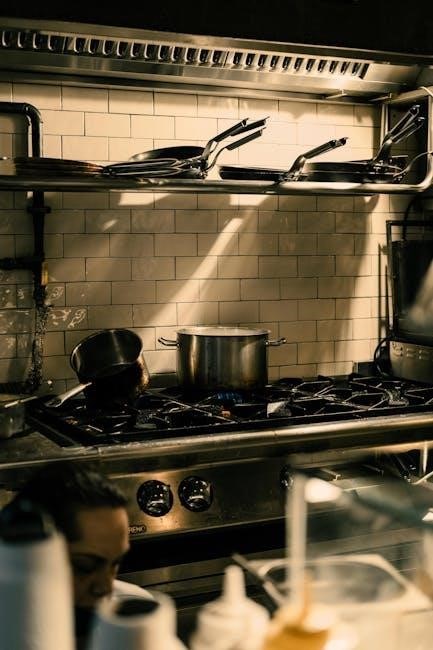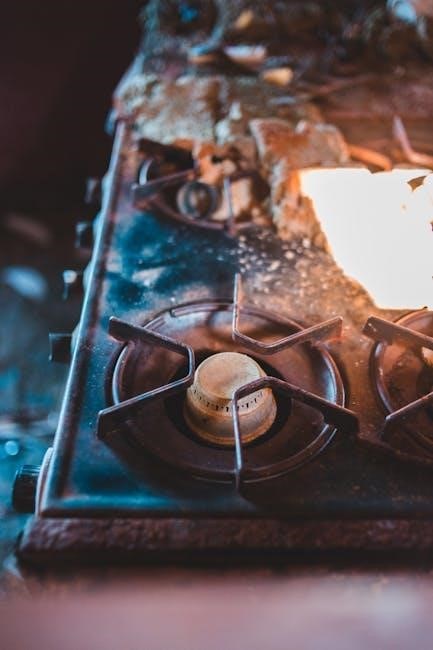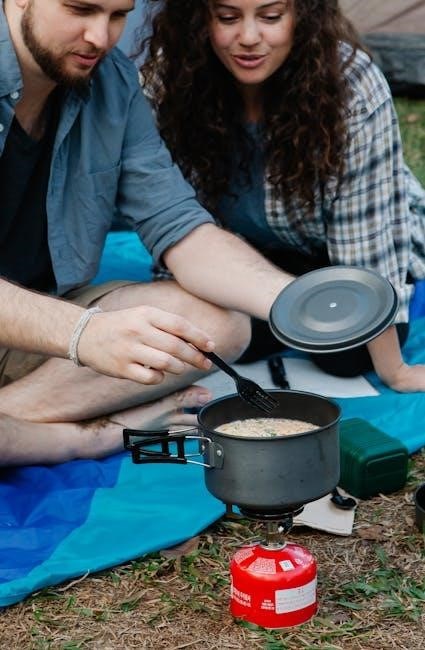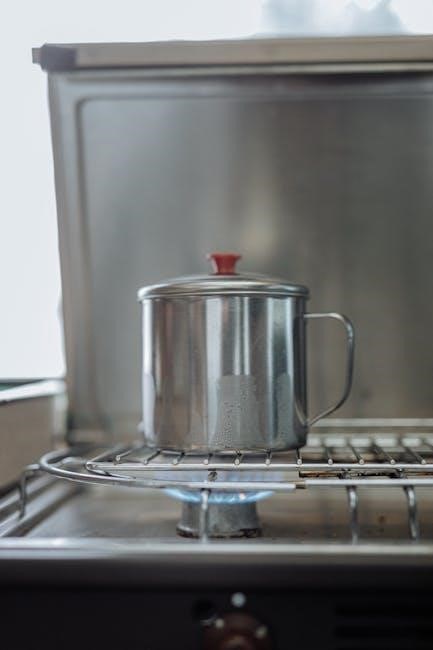Common Gas Stove Problems
Gas stoves can experience issues like burners not lighting, weak or uneven flames, ignition system malfunctions, strange noises, or the oven not heating properly, disrupting cooking routines.
1.1. Burners Not Lighting
Burners not lighting is a common issue that can stem from clogged burner ports, a faulty igniter, or moisture interfering with the ignition system. Food debris or spills may block gas flow, preventing the burner from igniting. Additionally, a wet or dirty igniter can fail to spark, while a malfunctioning gas valve might restrict gas supply. Always ensure the burner cap is properly aligned and clean. If the issue persists, checking the igniter and gas connections is essential for restoring functionality safely.
1.2. Weak or Uneven Flames
Weak or uneven flames on a gas stove can result from clogged gas ports, an improper air-fuel mixture, or low gas pressure. Food debris or dirt blocking the burner ports restricts gas flow, causing irregular flames. Additionally, if the air-fuel mixture is off, flames may appear yellow or uneven. To resolve this, clean the burner ports with a toothpick or small brush and ensure the gas pressure is set correctly. Adjusting the air shutters can also restore a steady, blue flame, improving cooking performance and safety.
1.3. Ignition System Issues
Ignition system problems can prevent burners or the oven from lighting. A faulty igniter, clogged spark holes, or worn-out spark modules are common causes. If the igniter is dirty or wet, it may fail to spark. Regular cleaning of the igniter and ensuring dry conditions can resolve this. However, if the issue persists, replacing the igniter or spark module may be necessary. A malfunctioning ignition system can lead to unreliable stove operation and safety hazards, making prompt attention crucial for proper functionality and safety.
1.4. Strange Noises or Smells
Unusual noises, such as hissing or clicking, and unpleasant odors can indicate serious issues with your gas stove. A hissing sound may signal a gas leak, while strange smells could point to blockages or malfunctioning components. If you notice these signs, turn off the gas supply immediately. Open windows for ventilation and avoid sparks. Persistent issues may require professional inspection to ensure safety and proper stove function, as ignoring these signs can lead to hazardous situations.
1.5. Oven Not Heating Properly
If your gas stove’s oven isn’t heating properly, it could be due to a faulty igniter, issues with the gas supply, or a malfunctioning thermostat. Check if the igniter is clean and functioning. Verify that the gas valve is fully open and the gas flow is unrestricted. Inspect the oven’s heating element for damage or wear. If the problem persists, ensure the thermostat is working correctly or consider replacing it. Addressing these issues promptly can restore your oven’s heating performance and ensure safe operation.

Troubleshooting Burner Issues
Troubleshooting burner issues involves checking for clogged ports, ensuring proper gas flow, and verifying igniter function. Cleaning burners and adjusting the air-fuel mixture can resolve many problems.
2.1. Causes of Burners Not Lighting
Burners not lighting can stem from clogged gas ports, a faulty igniter, or issues with the gas supply. Food debris or spills may block the gas flow, preventing ignition. Additionally, a wet or dirty igniter can fail to spark, while a disconnected or kinked gas line can halt fuel delivery. Electrical problems, such as a tripped circuit breaker or failed spark module, may also prevent burners from lighting. Identifying and addressing these root causes is crucial for restoring proper burner function.
2.2. How to Fix a Burner That Won’t Light
To fix a burner that won’t light, start by ensuring the gas supply is on and the burner cap is properly aligned. Clean the igniter with a dry cloth or brush, and ensure it’s free from debris. Check and clear any blockages in the gas ports using a toothpick or small brush. Inspect the gas line for kinks or damage and ensure the stove is plugged in or has a working gas connection. If issues persist, professional assistance may be necessary to address internal malfunctions.
2.3. Adjusting the Air-Fuel Mixture for Better Flames
Adjusting the air-fuel mixture ensures optimal combustion. Start by locating the air shutters near the burner base. Using a screwdriver, gently open or close the shutters to regulate airflow. A proper mix produces a steady, blue flame. Avoid over-adjusting, as this can destabilize the flame. Clean the burner ports with a toothpick to ensure unobstructed gas flow. After adjustments, test the flame by lighting the burner and observing its stability. Proper adjustment enhances cooking efficiency and safety.

Ignition System Troubleshooting
Address ignition system issues by ensuring the gas supply is on, cleaning the igniter, and checking for blockages. Spark or click issues may require professional assistance.
3.1. Why the Igniter Might Not Spark
The igniter may fail to spark due to dirt, moisture, or food residue accumulation. Faulty wiring or a damaged ignition module can also prevent sparking. Additionally, a malfunctioning spark electrode or worn-out ignition components can cause issues. If the igniter is dirty or wet, it may need cleaning or drying. In some cases, a damaged igniter might require replacement. Always ensure the gas supply is turned off before attempting any maintenance or repairs to avoid safety hazards.
3.2. Cleaning and Replacing the Igniter
To clean the igniter, turn off the gas and power supply. Remove the burner cap and grates to access the igniter. Use a soft brush or toothpick to gently remove dirt or food residue. For replacement, purchase a compatible igniter and follow the manufacturer’s instructions. Ensure the stove is cool and unplugged before starting. If unsure, consult a professional to avoid safety risks. Regular cleaning can prevent future ignition issues and ensure reliable performance.

Addressing Weak or Uneven Flames
Weak or uneven flames can result from clogged gas ports or an improper air-fuel mixture. Cleaning the burner ports with a toothpick and adjusting the gas pressure often resolves the issue.
4.1. Checking for Clogged Gas Ports
Clogged gas ports are a common cause of weak or uneven flames. Food debris, grease, or dirt can block the ports, restricting gas flow. To check, turn off the stove and let it cool. Remove the burner caps and inspect the ports for any obstructions. Use a toothpick or small brush to gently clean out any blockages. Ensure the ports are free of residue before reinstalling the caps. Regular cleaning prevents future issues and maintains proper flame quality.
4.2. Ensuring Proper Gas Pressure
Proper gas pressure is essential for consistent and safe flame production. Low or high gas pressure can cause weak or uneven flames, affecting cooking performance. Check the gas regulator to ensure it’s set correctly, as outlined in your stove’s manual. If adjusting the regulator doesn’t resolve the issue, contact a professional to inspect the gas line or pressure. Maintaining correct pressure prevents safety hazards and ensures optimal stove functionality. Regular checks can help identify pressure-related issues early, avoiding costly repairs;

Safety Precautions
Always ensure the pilot light stays lit to maintain safety and prevent gas leaks. If it won’t stay lit, seek professional help immediately to avoid hazards.
5.1. What to Do If You Smell Gas
If you detect a gas odor, act immediately to ensure safety. Do not light matches or turn on electrical devices, as this could ignite the gas. Open windows for ventilation and leave the premises if the smell is strong. Contact your gas company’s emergency number or a professional technician to address the potential leak. Never attempt to repair a gas leak yourself, as this can lead to dangerous consequences.
5.2. Handling a Pilot Light That Won’t Stay Lit
If the pilot light on your gas stove keeps going out, it may indicate a problem with the thermocouple, gas valve, or drafts affecting the flame. First, ensure the area is well-ventilated and free from strong drafts. Clean the pilot light area to remove any debris. If the issue persists, check the thermocouple for proper alignment and function. If the pilot light continues to malfunction, it’s best to contact a professional for assistance, as this could signal a deeper issue requiring expert repair.

Maintenance Tips
Regular maintenance is key to preventing gas stove issues. Clean burner caps and ports, check gas connections for leaks, and ensure proper ventilation to maintain efficiency and safety.
6.1. Cleaning the Burner Caps and Ports
Regularly cleaning the burner caps and ports is essential for maintaining your gas stove’s performance. Turn off the stove and let it cool completely. Remove the burner caps and grates, then wash them with mild soap and warm water. Use a toothpick or small brush to clear food debris from the burner ports. Dry all parts thoroughly before reinstalling. This helps ensure proper gas flow and prevents uneven flames or ignition issues. Cleaning regularly can also prevent clogs and extend the lifespan of your stove.
6.2. Regular Inspections for Early Problem Detection
Regular inspections are crucial for identifying potential issues before they escalate. Check the igniter for cleanliness and functionality, ensuring it sparks properly. Inspect the gas ports for blockages and clean them if necessary. Verify that all connections are tight and free from leaks. Look for signs of wear on burner caps and ensure they are properly aligned. These checks can help detect issues early, improving safety, efficiency, and preventing costly repairs. Regular maintenance also extends the lifespan of your gas stove and ensures optimal performance.

When to Call a Professional
Call a professional if you detect a gas leak, notice persistent ignition issues, or suspect internal damage. Experts handle complex repairs safely and efficiently.
7.1. Signs That You Need Expert Help
If you notice a persistent gas leak, hear unusual noises, or experience recurring ignition failures, it’s time to call a professional. Additionally, if your stove’s burners won’t light despite troubleshooting, or if there’s visible damage to components like the igniter or gas lines, expert assistance is crucial. Professionals can safely address complex issues, ensuring your stove operates efficiently and safely, especially when DIY repairs aren’t feasible or pose a risk.
7.2. Gas Leak Repair and Safety
A gas leak is a critical issue that requires immediate attention. If you smell gas, do not ignite flames or switches. Open windows for ventilation and leave the area. Contact a professional to inspect and repair the leak, as DIY attempts can be dangerous. Regular inspections of gas lines and connections help prevent leaks. Always ensure proper installation and maintenance to avoid hazards. Remember, gas safety is paramount to prevent accidents and ensure a safe cooking environment.
Regular maintenance and prompt repairs enhance gas stove safety and efficiency. Addressing issues early ensures reliable performance and extends lifespan, keeping your kitchen operations smooth and hazard-free.
8.1. Importance of Regular Maintenance
Regular maintenance is crucial for ensuring your gas stove operates safely and efficiently. Cleaning burners, checking gas connections, and inspecting ignition systems prevent malfunctions. Proper upkeep also reduces the risk of hazards like gas leaks or uneven flames. By addressing issues early, you extend the stove’s lifespan and maintain optimal cooking performance. A well-maintained stove not only enhances safety but also supports energy efficiency, making it a worthwhile investment for your kitchen.
8.2. Extending the Lifespan of Your Gas Stove
Proper care and maintenance can significantly extend the lifespan of your gas stove. Regular cleaning of burner caps and ports prevents clogs and ensures efficient combustion. Inspecting gas lines for leaks and addressing issues promptly avoids major repairs. Replacing worn-out parts, like igniters or burner grates, when necessary, also prolongs functionality. A well-maintained stove can last 15-20 years. However, if repairs become frequent or exceed half the cost of a new stove, it may be time to consider a replacement for safety and efficiency.
